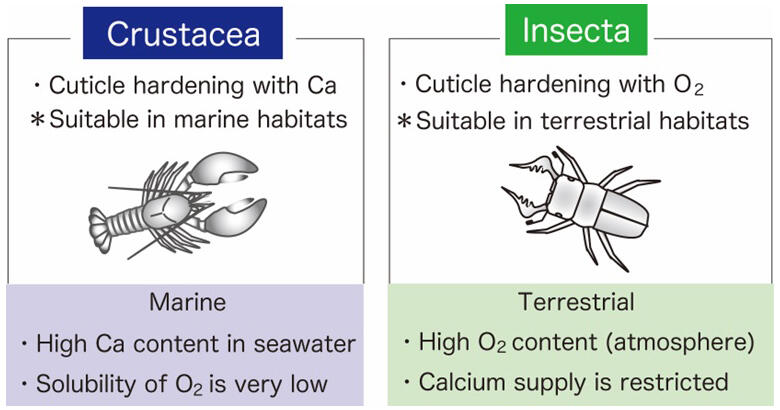Insects are considered as the most diverse organisms on earth, with more than one million described species. Although insects have adapted to all terrestrial environments by taking advantage of their wings and other features, very few species have adapted to marine environments. The reasons for this have been widely examined but remain unclear among researchers and insect enthusiasts.
Assistant Professor Tsunaki Asano of the Graduate School of Science at Tokyo Metropolitan University, Assistant Professor Kosei Hashimoto, of the Center for Data Science Education & Research at Kyorin University and their colleagues have focused on the exoskeleton of insects, which is an important body structure in arthropods. They have evaluated the mechanisms of exoskeleton generation, particularly hardening, and published a new hypothesis for why insects are rarely found in the ocean in the journal Physiological Entomology.

Provided by Tokyo Metropolitan University
Various hypotheses have been proposed to explain why insects are not found in the sea, such as their inability to adapt to seawater (osmotic pressure, salinity), tracheal collapse because of water pressure and high predation pressure. However, these predictions have been proven incorrect, as species that can survive in the open ocean, underwater and deep sea have been reported. Since no convincing hypothesis from the perspective of insect physiology has been presented, the most likely hypothesis relies on the conceptional interpretation based on the ecological terms that "potential niches are already occupied by other organisms, including crustaceans, leaving no niche for insects to occupy." Although this explanation is possible, the reasons why insects do not inhabit the ocean still remain unclear.
The research group has proposed the following hypothesis: During hardening of the exoskeleton, insects require a chemical reaction involving oxygen as a cofactor; however, water contains only 1/30 of the amount of oxygen as air on land, which could be one of the factors preventing insects from entering the ocean. In contrast to oxygen‐rich land, crustaceans that are close relatives of insects, thrive successfully in the seawater. Crustaceans are dominant in seawater, specifically dominating in the amount of krill resources and use calcium, which is abundant in seawater, to harden their exoskeletons.
Both insects and crustaceans are arthropods and compete for the same habitat. The environment of the seawater inhabited by the crustaceans, which have strong exoskeletons made of calcium, is too harsh for insects due to which they cannot efficiently harden their exoskeletons. The key point of this hypothesis is that traits that were advantageous during adaptation to the terrestrial environment may be disadvantageous for surviving in the sea. As a result this unique hypothesis has not been proposed previously.
Journal Information
Publication: Physiological Entomology
Title: Eco‐evolutionary implications for a possible contribution of cuticle hardening system in insect evolution and terrestrialisation
DOI: 10.1111/phen.12406
This article has been translated by JST with permission from The Science News Ltd. (https://sci-news.co.jp/). Unauthorized reproduction of the article and photographs is prohibited.




